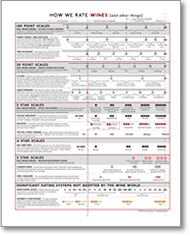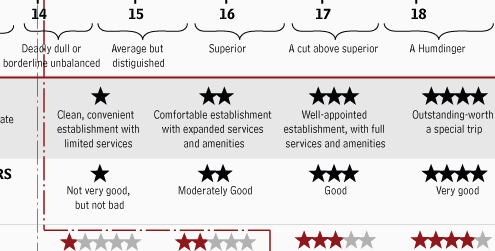Note: the bulk of this article is an accompanying chart that compares the major scoring systems now used, from 3 stars to 100 point scales (see it online here).
If you watched the movie Mondovino, you may have come away with the impression that the 100 point rating wine rating system is the root of all evil. But what about all the other wine rating systems? Are they evil as well? Of course they’re evil! But more of a necessary evil than a vast dark conspiracy. With a few prominent exceptions – Hugh Johnson, Oz Clarke, Robin Garr come to mind – all wine writers use them in one form or another. Take a look and judge for yourself.
I'm a recent convert to the 5 star system from the 100 point system. Why? I swear it has nothing to do with a recent move from the US to the UK (so I don’t want to hear any “dude, why do you hate your country?” comments). Instead, it's because I found myself spending too much time dwelling on meaningless distinctions such as: "is it an 88 or an 89, etc." I then swore off ratings altogether aside from putting one star or two stars on notes of wines I found exceptional. After doing this for a few years, the Eureka moment struck: “why not just use a 5 star system?” I like the 5 star scale because of its simplicity but don’t feel strongly enough about it to fiercely defend it.
It just seems that debates over wine rating systems resemble PC vs. Mac arguments: they just don’t go anywhere. The choice of a rating scale is just as personal as the act of rating wines; at the end of the day they’re simply useful tools and not declarations of political affiliation.




Comments
Steve,
People love ratings because they provide a simple way to deal with a very complicated topic. It isn’t easy to convey in words how something tastes, nor is it easy to explain to everyone why you judge a wine to be ‘a certain way’ and how that correlates with their own experience.
On the other hand, you tell me “89” and, by gumbo, I know just what that means! :^)
Hi Jeff, is your smilie sticking up its nose? It appears that way but I can’t tell. I do, however, know exactly what an 89 means and that is 4 stars ;)
Bo Barrett, the winemaker for Chateau Montelena, has these three classifications:
1. Wines he would buy and drink.
2. Wines he would drink if someone else bought them.
3. Wines he would not drink regardless of someone elso buying them.
Burgundy was great.
Hi Eric,
Thanks for that — a very practical system!
Steve,
When are you going to introduce the term “naff” to your scale. I like the use of it in the German Australian article.
Eric
Is there any site used for rating wine lists? I have been getting a list of questions from people on my site so I built, a wine list section. After reading this, I want to find somewhere to ranking wine lists! :D
liked your view on judging and rating systems.Our noses, mouths, and brains are not laboratory instruments.I prefer a star system as it doesn’t pretend to be accurate
Lisa
lisa@thegreatestvitaminintheworld.com
www.thegreatestvitaminintheworld.com